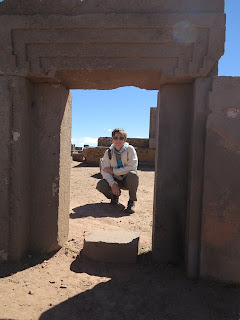Yesterday, we went on a day trip to a major archeological site near Lago Titicaca, called
Tiwanaku. It is amazing to think that a civilization that developed over close to 2,700 years and achieved obviously significant scientific knowledge would simply disappear into oblivion. And yet, there is so little known about this civilization and its apparent capabilities, it is almost shocking. I mean, the Inka empire lasted barely one century, and yet we seem to be fascinated by its achievements. Like Machu Picchu, Tiwanaku had to be discovered again to gain some importance as something more than a ¨quarry¨ for local construction and for looting of all its metal ornaments. Indeed, Isabel, our La Paz hostess told us that a museum in Berlin has the largest collection of gold from the Tiwanaku civilization.
For Tiwanaku we do not even know the name it was known by its original inhabitants. And, yet, the empire expanded to perhaps 2 million square km at its height. That´s one fifth of th size of Canada, which is huge.
Excavations are ongoing now, but proceeding slowly. The whole site was a jumble of stones, many impressive ones, but no one knows how they fit together. Reconstruction has been problematic as efforts are made to recreate the temples, but in some cases that has meant using adobe blocks to fill in blanks and in others cement has been used to aid that reconstruction.
This site is 72 km from La Paz and 20 km from Lago Titicaca in a valley that parallels the Cordillera Real. It sits at about 3,850 metres above sea level.
 |
| Detail of the Puerta del Sol. It served as a calendar. Like most ruins it is not in its original place. |
 |
| A monolith that is well conserved, even though the Spanish tried to cut off its head. The stone was too hard. The images throughout the monolith are symbols important to this culture and some also serve a bit of time keeping. |
 |
| The rebuilt Kalasasaya temple with another Puerta del Sol and a monolith that aligns perfectly on June 21 for solstice. Apparently thousands converge here to celebrate this event. |
 |
| Semi-subterranean temple has many carved heads in the wall. I took pictures of the orignal ones but there are also seven copies that have been embedded in another wall to show what they might have looked like before erosion and looting. |
 |
| How does an ancient civilization know to carve such perfect H? I´m just here for scale :) |
 |
| The mathematical know-how and crafty skills are obvious in the detail of these carved rocks. No-one knows how this puzzle fits together now. |
 |
| Pumakuna featues huge stones, some weighing several tons. They carry obvious markings of areas where precious metals once adorned them. |
 |
| A small door with Jan offering scale this time :) |
 |
| And yes, it is windy on the Altiplano! |
No comments:
Post a Comment